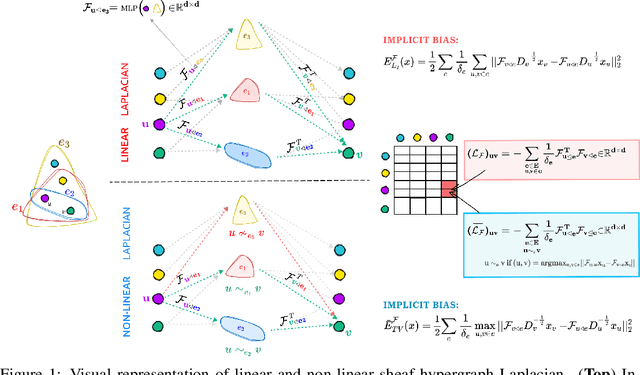Giulia Cassarà
Sheaf Hypergraph Networks
Sep 29, 2023



Abstract:Higher-order relations are widespread in nature, with numerous phenomena involving complex interactions that extend beyond simple pairwise connections. As a result, advancements in higher-order processing can accelerate the growth of various fields requiring structured data. Current approaches typically represent these interactions using hypergraphs. We enhance this representation by introducing cellular sheaves for hypergraphs, a mathematical construction that adds extra structure to the conventional hypergraph while maintaining their local, higherorder connectivity. Drawing inspiration from existing Laplacians in the literature, we develop two unique formulations of sheaf hypergraph Laplacians: linear and non-linear. Our theoretical analysis demonstrates that incorporating sheaves into the hypergraph Laplacian provides a more expressive inductive bias than standard hypergraph diffusion, creating a powerful instrument for effectively modelling complex data structures. We employ these sheaf hypergraph Laplacians to design two categories of models: Sheaf Hypergraph Neural Networks and Sheaf Hypergraph Convolutional Networks. These models generalize classical Hypergraph Networks often found in the literature. Through extensive experimentation, we show that this generalization significantly improves performance, achieving top results on multiple benchmark datasets for hypergraph node classification.
Sheaf Neural Networks for Graph-based Recommender Systems
Apr 07, 2023



Abstract:Recent progress in Graph Neural Networks has resulted in wide adoption by many applications, including recommendation systems. The reason for Graph Neural Networks' superiority over other approaches is that many problems in recommendation systems can be naturally modeled as graphs, where nodes can be either users or items and edges represent preference relationships. In current Graph Neural Network approaches, nodes are represented with a static vector learned at training time. This static vector might only be suitable to capture some of the nuances of users or items they define. To overcome this limitation, we propose using a recently proposed model inspired by category theory: Sheaf Neural Networks. Sheaf Neural Networks, and its connected Laplacian, can address the previous problem by associating every node (and edge) with a vector space instead than a single vector. The vector space representation is richer and allows picking the proper representation at inference time. This approach can be generalized for different related tasks on graphs and achieves state-of-the-art performance in terms of F1-Score@N in collaborative filtering and Hits@20 in link prediction. For collaborative filtering, the approach is evaluated on the MovieLens 100K with a 5.1% improvement, on MovieLens 1M with a 5.4% improvement and on Book-Crossing with a 2.8% improvement, while for link prediction on the ogbl-ddi dataset with a 1.6% refinement with respect to the respective baselines.
 Add to Chrome
Add to Chrome Add to Firefox
Add to Firefox Add to Edge
Add to Edge